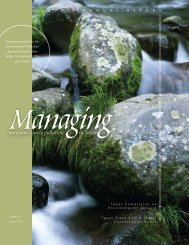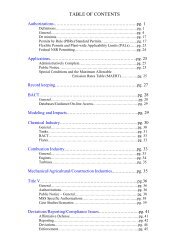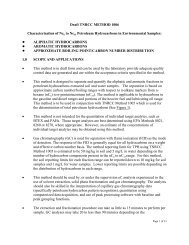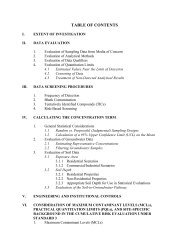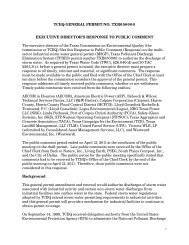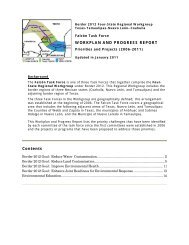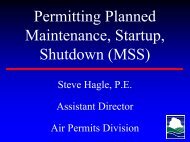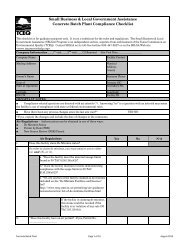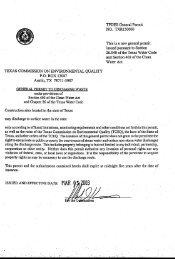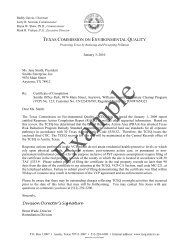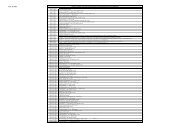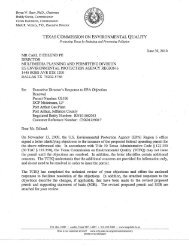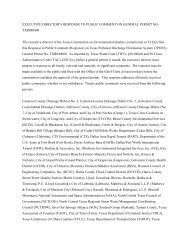Joint Groundwater Monitoring and ... - TCEQ e-Services
Joint Groundwater Monitoring and ... - TCEQ e-Services
Joint Groundwater Monitoring and ... - TCEQ e-Services
Create successful ePaper yourself
Turn your PDF publications into a flip-book with our unique Google optimized e-Paper software.
evisions effective on February 5, 1997, established a certification <strong>and</strong> continuing<br />
education requirement for On-Site Sewage Facilities Installers, Apprentices,<br />
Designated Representatives, <strong>and</strong> Site Evaluators. All certifications required by rule<br />
were in place effective August 1, 1998. The regulations also required that new<br />
OSSFs be designed <strong>and</strong> constructed using current technology <strong>and</strong> that older failing<br />
systems be brought up to current st<strong>and</strong>ards. Rule revisions effective on June 13,<br />
2001, provided the <strong>TCEQ</strong> <strong>and</strong> its local regulating entities more enforcement tools to<br />
ensure that proper systems are installed, inspected, operated, <strong>and</strong> maintained. Rule<br />
revisions effective on August 29, 2002, provided <strong>TCEQ</strong> with the authority to charge<br />
a fee up to $500 per permit if the local permitting entity relinquishes its authority of<br />
the program or if the entity’s program is revoked by the <strong>TCEQ</strong> for failure to<br />
satisfactorily operate under state rules <strong>and</strong> regulations. Rule revisions effective on<br />
September 11, 2003, were administrative in nature in an effort to clarify requirements<br />
for issuing <strong>and</strong> renewing licenses <strong>and</strong> to achieve consistency with other legislation<br />
(Professional Geoscientists Practice Act). Rule revisions effective on April 28, 2004,<br />
addressed the disposal of water softener discharge <strong>and</strong> revisions effective on January<br />
6, 2005 addressed the disposal of graywater. Rule revisions effective on August 3,<br />
2006, addressed aerobic system maintenance, the registration of maintenance<br />
companies <strong>and</strong> established requirements for homeowners who choose to maintain<br />
their aerobic system without contracting with a maintenance company. This revision<br />
also changed the definition of “subdivision” <strong>and</strong> provided direction for design of<br />
mound <strong>and</strong> soil substitution disposal options. Rule revisions effective on September<br />
11, 2008 addressed the training of individuals servicing wastewater treatment devices<br />
<strong>and</strong> increased the treatment capacity of devices commonly used in OSSFs.<br />
Construction of an OSSF treatment <strong>and</strong> disposal system must be isolated from certain<br />
areas such as water wells, lakes, roads, <strong>and</strong> other objects subject to contamination<br />
from the OSSF or that may prevent the proper operation of the system. To further<br />
ensure protection of groundwater, no individual may install, construct, alter, extend,<br />
or repair an OSSF unless the individual holds a valid certification issued by the<br />
executive director of the <strong>TCEQ</strong> or has a valid exemption from licensing<br />
requirements.<br />
Status of <strong>Groundwater</strong> <strong>Monitoring</strong> Programs. The Field Operations Support<br />
Division’s OSSF Program serves a complaint response function with regard to claims<br />
concerning contamination from OSSFs. Response to OSSF complaints is<br />
coordinated with either the appropriate <strong>TCEQ</strong> Regional Office or the local authorized<br />
agent <strong>and</strong> does not generally involve the monitoring of groundwater to detect<br />
contamination. When appropriate, during certain remediation or enforcement<br />
activities involving potential groundwater contamination, the <strong>TCEQ</strong> may perform or<br />
require groundwater monitoring to evaluate remediation progress or success.<br />
Status of <strong>Groundwater</strong> Contamination. There are no identified cases of<br />
groundwater contamination attributed to systems which fall under the OSSF program.<br />
Permitting <strong>and</strong> Registration Support Division<br />
The Permitting <strong>and</strong> Registration Support Division (PRSD) within the Office of<br />
Permitting <strong>and</strong> Registration (OPR) contributes to the protection of the state’s<br />
groundwater resources by functioning as a licensing entity. The PRSD licenses those<br />
environmental professionals who design, construct, install, remove, operate, <strong>and</strong><br />
41



